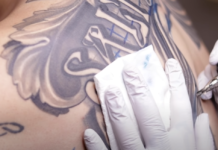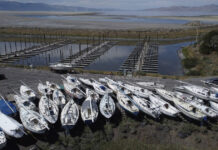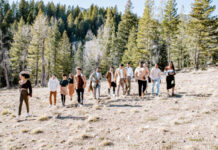
Each Memorial Day, the barren expanse of Utah’s west desert enjoys a small taste of tropical paradise.
Members of Utah’s Pacific Islander community head to the Iosepa Memorial in east Tooele County, where they celebrate their history and heritage. Sitting in the shadow of the Stansbury Mountains, this remote memorial consists of a cemetery and pavilion and lies near the original site of Iosepa, a turn-of-the-century Native Hawaiian settlement.
“[The celebration is] an important identity-affirming experience for many Pacific Islanders,” said West Valley City Councilman Jake Fitisemanu. It allows them, he said, to “participate in a social gathering that honors traditions and history.”
The event features traditional performances, prayer, and food, like huli-huli chicken and poi, a Polynesian staple made from fermented taro root.
Memorial Day serves as a fitting date for the annual gathering, as the Iosepan celebration reflects the national holiday’s spirit of remembrance and marks Asian American and Pacific Islander Heritage Month.
Fighting for survival
The Iosepan celebration was not always held in spring. It used to be called Hawaiian Pioneer Day, celebrated on August 28, the day the first Hawaiian pioneers settled in Iosepa in 1889.
In the 1850s, Joseph F. Smith, nephew of church founder Joseph Smith, served his mission for The Church of Jesus Christ of Latter-day Saints in Hawaii, and local converts, eager to worship in the mecca of the church, began trickling into Salt Lake City some years later.
The city’s residents, however, did not greet the transplants warmly. In her essay titled “Life at Iosepa, Utah’s Polynesian Colony,” historian Tracey E. Panek writes that “racial prejudice directed toward the immigrants contributed to tension between the Polynesians and the larger Salt Lake community.”
In 1889, a small group of both native Hawaiians and church officials chose to relocate the immigrants — about 50 men, women, and children, to start — west of Salt Lake City to a ranch in the west desert, an arid and harsh landscape 75 miles away.
Sepa Faupula, a student and mentor at Salt Lake Community College, imagines that their arrival must have been disheartening.
“I would feel like I was seen as unworthy,” Faupula said. “These people came over with this faith, only to be pushed aside.”
The Iosepans initially struggled to raise crops during the growing season and keep warm in the winter, but they eventually found their footing.
“Our people … have good relationships with the land,” Faupula said, referring to Hawaiians’ proclivity for agriculture. “They were able to thrive.”
It didn’t happen immediately, however. The first winter was particularly harsh, Panek writes, as snow and cold weather forced the residents to crowd indoors, causing an influenza outbreak. But the settlers grew accustomed to Utah’s climate, learning to prepare for the winter and completing an irrigation system to allow for successful growing seasons.
But in 1916, after the church announced the construction of a temple in Hawaii, residents left Iosepa as worship was now possible in their homeland. Whether the Iosepans left by choice or at the urging of the church remains unclear.

Settlers’ legacy
Today, almost 40,000 Pacific Islanders live in Utah, the vast majority of which reside in Salt Lake and Utah counties, according to the Utah Department of Health. Most are affiliated with The Church of Jesus Christ of Latter-day Saints, including 25 Samoan-speaking wards and more than 40 Tongan-speaking wards.
While some in the Pacific Islander community are aware of the role their forebears played in Utah history, this knowledge is not universal, Fitisemanu said.
“I think it’s generational,” he said. “My parents’ and grandparents’ generation[s] are more aware and more connected to the story and [the site].”
Awareness may not be the only generational divide.
“There’s been a resurgence of reclaiming our culture,” Faupula said, particularly among younger people, who, in today’s socio-political climate, are more likely to celebrate diversity, advocate for social progressivism and take a less forgiving view of historical injustices.
Older generations might be more inclined to find inspiration in the Iosepans’ ability to overcome adversity, Faupula said, but “[younger people] feel a lot more resentment … [the Iosepans] shouldn’t have had to prove themselves,” suggesting the establishment of a desert colony was an unfair obstacle for the Pacific Islander cohort to overcome in proving their worth to the church.
While Utah’s population is about 90% white, per data from the U.S. Census Bureau, the state still hosts many communities with rich cultural histories ripe for celebration. The Memorial Day celebration at Iosepa is one such example, and an opportunity to learn about an overlooked chapter in Utah history.
The event, which is free and open to the public, has been postponed this year, according to a statement issued by the Iosepa Historical Society. The celebration will be rescheduled “due to the ongoing uncertainty of the Covid-19 pandemic,” though postponement does not preclude visitors from gathering.
“We welcome you and your ‘ohana (family) to come and pay your respects,” the statement reads.
More information can be found on the society’s website.







